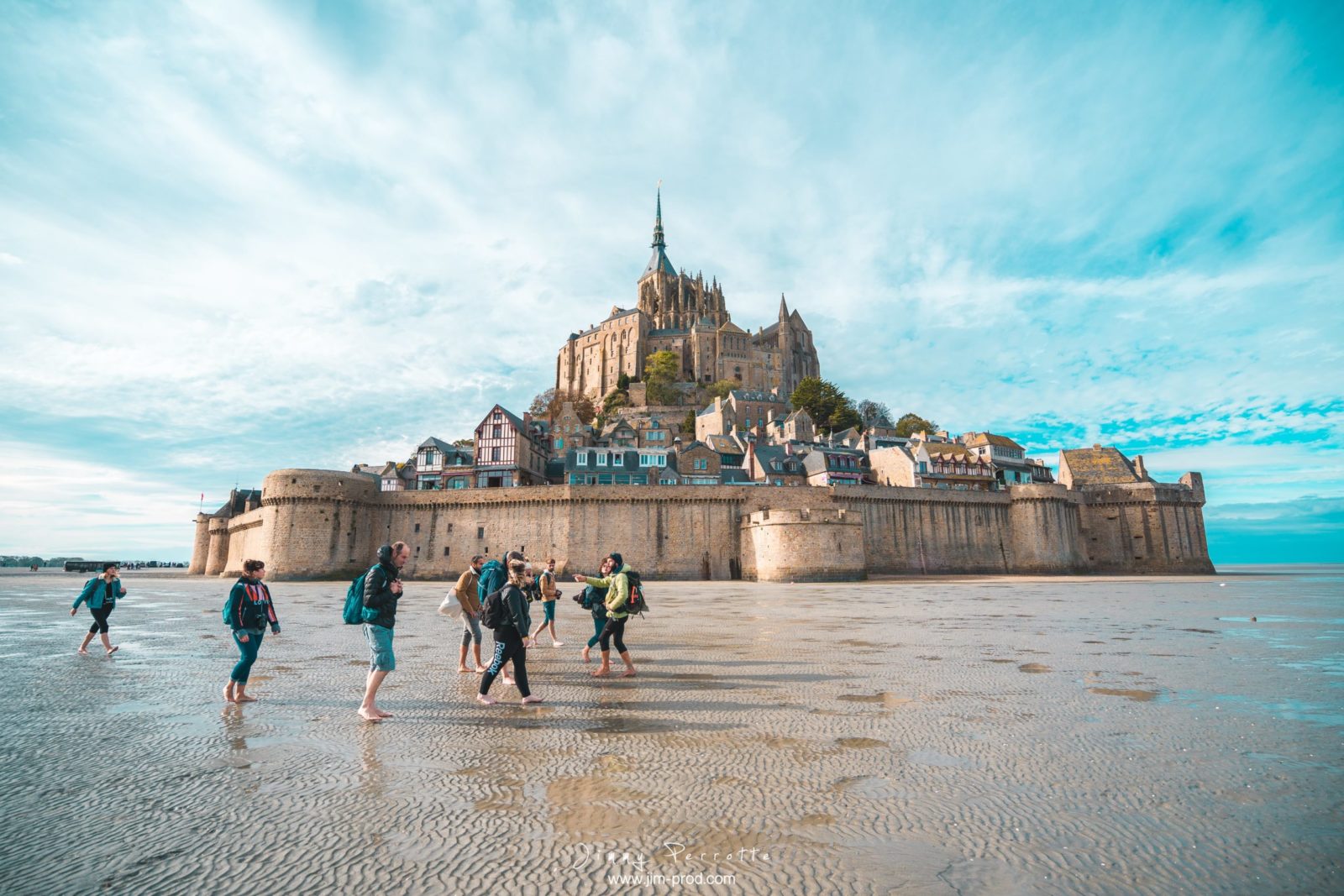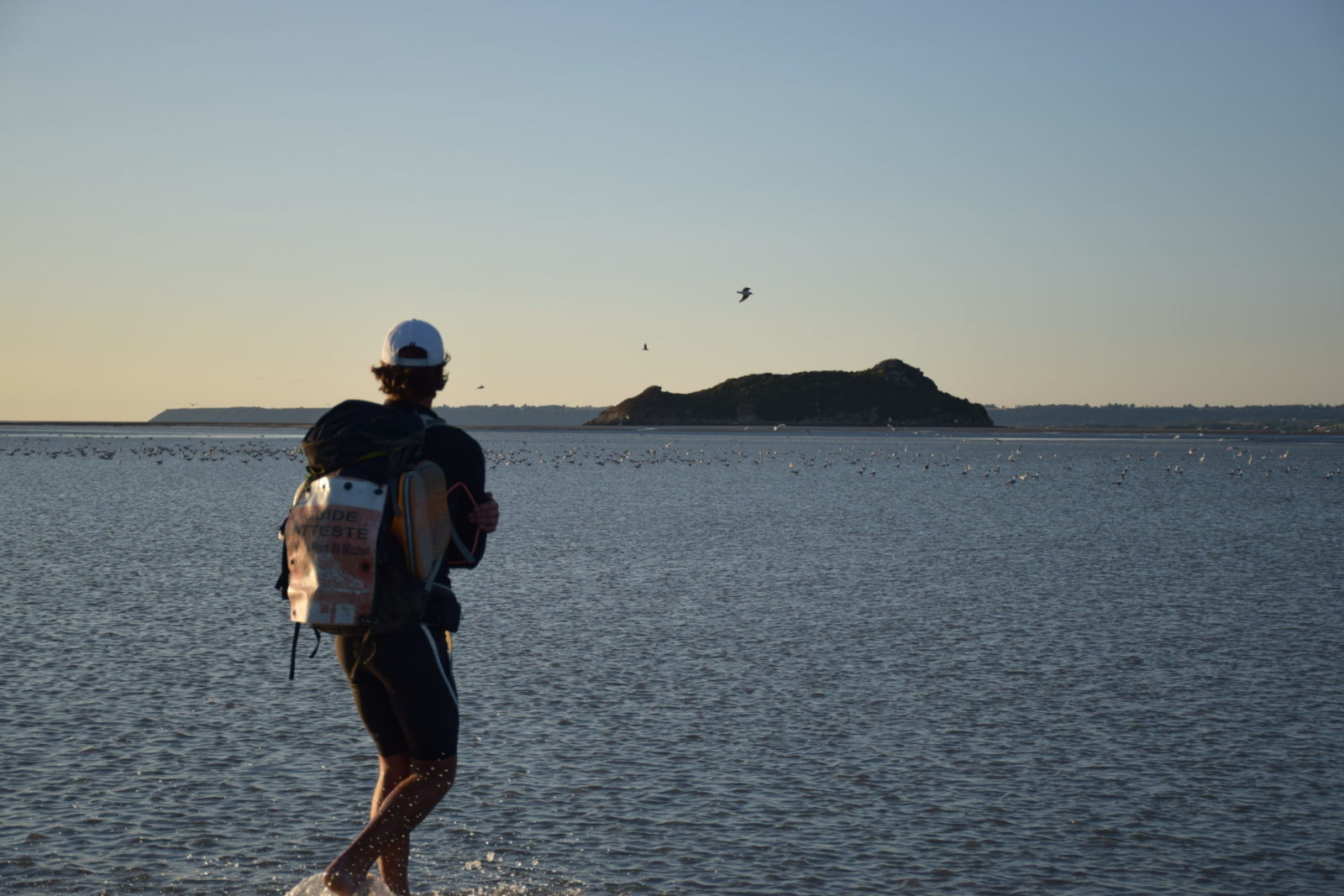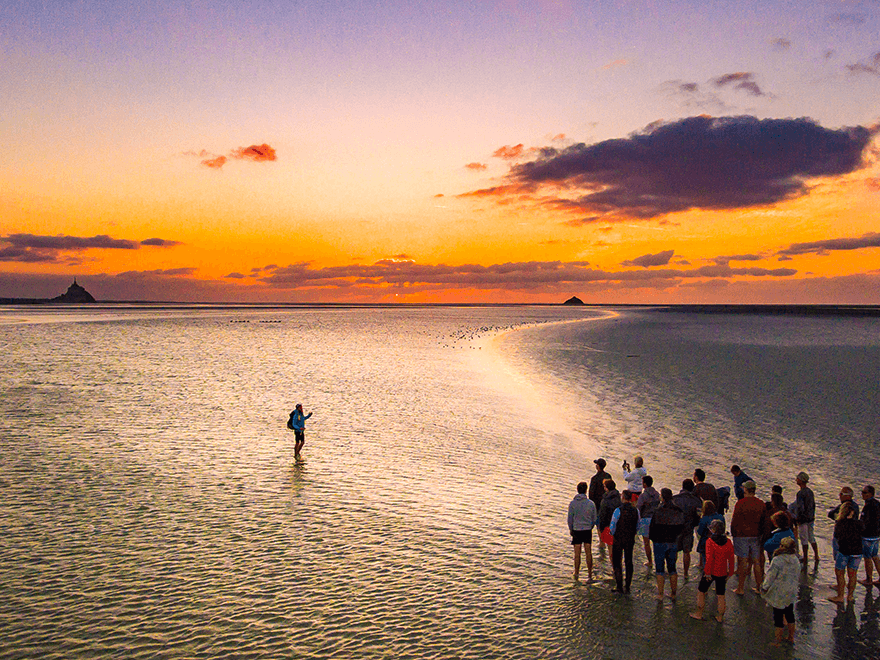Located between Brittany and the Norman peninsula of Cotentin, the Bay of Mont-Saint-Michel is listed as one of the most beautiful bays in the world. It extends from the cliffs of Champeaux (east coast) to the Pointe du Grouin in Cancale (west coast), 23 kilometres from the mouth. The bay represents an area of 450km².
Here, architecture and nature combine perfectly.
It is the scene of the highest tides in Europe and has been a UNESCO World Heritage Site since 1979.
In some years, the tidal range can reach 15 metres in height.
The foreshore thus opens up several dozen kilometres out to sea, allowing fishermen, hunters, birdwatchers, walkers and pilgrims to venture out for the duration of a tide.
This bay is full of dangers, among them the famous quicksand. Far from being legendary, many people have been trapped there. It is a natural and physical phenomenon which consists, via
It is a natural and physical phenomenon which consists, via vibrations on the ground, in transforming “La Tangue” (sandy-muddy mixture) from a solid state to a liquid state. After some practice, it is easy to get out of it…
It is necessary to know the tide times, or to take a professional and recognised guide to venture out. The bay is not flat and uniform. Many people have found themselves surrounded by sandbanks and trapped by the tide.
Here, the sea goes away very far but also comes back very fast, with the legendary speed of the galloping horse. (T.Gauthier)
The bay is full of riches and a unique and sensitive fauna.
In terms of hunting, as winter approaches, more than 1,500 different species of birds pass through the estuary on their way back from their nesting grounds in the Nordic countries to
the Iberian Peninsula to spend the winter in warmer countries. The Bay plays an essential role in their migration, taking advantage of the ebb and flow of the tides to rest, gather and feed on the Foreshore.




Among them are the famous brant, which come in their thousands to winter on our salt meadows, the largest in Europe (over 4000 hectares).
From a fisheries point of view, it is not uncommon to observe marine mammals (grey seals and sea calves) in the waterways, taking advantage of the tidal cycle to come and fatten up in the estuary with flatfish or other mullets…
Not forgetting the king of fishes, “Salmo Salar”, the Atlantic salmon, 100% wild and migratory too. The Bay has always had large populations of salmon, returning from their fattening areas
from their fattening areas and after having eaten shrimps off Newfoundland, Greenland or the Faroe Islands. They return to their native rivers to reproduce in their turn.
Salmon fishing was one of the main human activities in the Bay and an important source of income until its definitive closure (end of the 20th century).
Along with cockle fishing (coquetières or pieds-rouges) and salt production (sauliers).
While the rocks of the bay of Mont-Saint-Michel (Tombelaine, Mont-St-Michel and Mont-Dol) appeared 540 million years ago as a result of numerous magmatic upwellings.
The human and religious history of this bay did not appear until the 8th century.
In 708, the bishop Aubert of Avranches saw a dream appear in a deep sleep: the Archangel Michael. The latter appeared to him and ordered him to build a sanctuary in his honour where
his merits, at the top of Mont Tombe (former name of Mont-Saint-Michel).
This oratory, built by the hands of the bishop, will remain Norman and will become a major place of pilgrimage in Europe. It became the Bay of Legends.
These pilgrims are called Miquelots, descendants of Michel in Latin Michaël (meaning in Hebrew: who is like God).
They have been crossing the bay for more than 1300 years and nowadays they continue to follow these routes to entrust their souls to the Holy of Holies… It is the ultimate forgiveness.
Mont-Saint-Michel has been through many periods and wars.
In the 10th century, under Saint Benedict, the Benedictines, the great architects and builders of the time, considerably enlarged the small oratory of Bishop Aubert. This was the beginning of a colossal project
which later gave rise to a magnificent abbey church.
In the Millennium, Mont-Saint-Michel became a source of profit, and the first hoteliers and restaurateurs settled in the small village of Montois.
In the 13th century, another splendid construction was built on the cliff face, right on the granite, with its two large architectural parts (Gothic and Romanesque) on three levels: La Merveille, (west face of the mountain), it watches over the sea, the sea watches over it…
The Mont-Saint-Michel, will resist firmly during the English invasion during the Hundred Years War (in the 14th and 15th century). During this period, the French garrison remained protected by the head of the heavenly militia, “L’Archange Michel”, while the whole of Normandy was in the hands of the English.
Not far from here, the Rocher de Tombelaine, became a great English fortress preventing any French supplies from the estuary. The French garrison drew strength and courage to stay alive until their victory in 1450 (Battle of Formigny).
During the French Revolution, the Abbey of Mont-Saint-Michel became the “Bastille of the Seas”, a cruel and frightful prison where nearly 14,000 prisoners were crammed, among them, serious criminals as well as refractory priests who refused to submit to the new constitution. The
torture was omnipresent.
At the end of this sad and dark period, Mont-Saint-Michel needed to be restored, and many French architects came to work there.
After these major restoration works, the monument quickly became a popular tourist attraction. It even became a centre of economic interest for certain restorers, such as Annette Poulard,
who arrived on the Mount as a servant at the end of the 19th century and is now the emblematic figure of the Mount.
Nowadays, Mont-Saint-Michel has become the number one tourist site in France, with more than 2.5 million visitors per year.
Two great local specialities are to be found in the region, the salt meadow lamb grazing on halophilic plants on the shores (herbus de prés-salés) and the Cancale oysters, recently classified as intangible heritage by UNESCO.
As part of the restoration of the maritime character of Mont-Saint-Michel, a project unique in the world came into being in 2015, the result of 20 years of work. The road dike that linked Mont-Saint-Michel to the coast was destroyed to make way for a footbridge (allowing the ebb and flow of the tides to circulate freely). The car parks are now set back from Mont-Saint-Michel, so the site is not denatured. Free shuttle buses take visitors to the monument.
Indeed, Mont-Saint-Michel was doomed to lose its insularity by 2040, due to the natural silting up of the estuary as a result of the tidal cycles. Without this huge project, Mont-Saint-Michel would have ended up inland (salt meadows) which are rapidly advancing towards the sea.
Since 2015, a dam built upstream on the Couesnon 1.5km from Mont-Saint-Michel has been releasing water twice a day at the rhythm of the tides. From this artificial and extremely powerful current, the fine sediments deposited by the tide are transported out to sea in order to preserve the island character of Mont-Saint-Michel.
From March to October, the Bay of Mont-Saint-Michel is very popular with tourists who come to cross the bay like medieval pilgrims. Accompanied by a guide for their safety, they cross the coastal rivers of the estuary, understand the history and discover the riches of this
exceptional heritage. They will also test the famous quicksand and approach the Mont-Saint-Michel in an extraordinary way.
In many contexts, school groups, associations, seminars, individuals, etc…
With family or friends…
The Bay is, and will remain, a great place for meeting and sharing…
Welcome to the Bay of Legends…
LUDOVIC COULON



Vous souhaitez davantage d’informations ou tout simplement
réserver un créneau horaire pour une prochaine traversée de la Baie du Mont-Saint-Michel ?
Contactez-moi ! Je vous répondrai dans les plus brefs délais.







